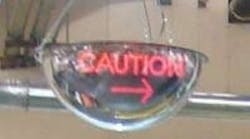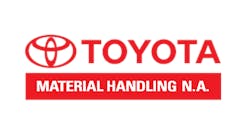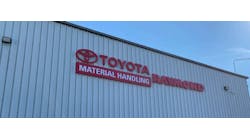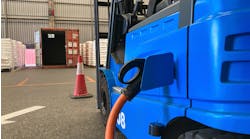Creating safe warehouses and distribution centers is a team effort that includes communication, training programs, safety incentives, and safety products. Safe operations are clean, organized and more productive. Employees know where to put and where to find product and they feel that managers care about them.
Safety has to start from the top down and be data driven, says Dixie Brock, national safety and claims manager for APL Logistics (Oakland, Calif., www.apllogistics.com). Brock tracks APL's safety in parallel with its accounting periods, which makes it easier to communicate the cost of injuries and other incidents. "Claims information gives the financial data needed to communicate loss effectively to senior management," she says.
Claims data is important because warehouses and DCs usually have high insurance deductibles and take a direct hit to their bottom line when accidents or product losses occur. Brock also uses APL's claims data to produce safety support tools for APL's warehouses. One of these tools is a series of monthly training programs based on problem areas that the claims data highlight. She follows up by requiring accountability from the field to make sure training is completed. Such programs have helped APL reduce its claims and OSHA recordable incidents by 20% per year.
Spread the word
Warehouses and DCs with better safety records are more productive. Doug Tatum, an APL logistics general manager, says the two facilities he manages in Atlanta use the safety programs that Brock sends out every month. In addition, his employees develop and present their own safety meetings on topics such as staying safe in the heat of an Atlanta summer and parking lot safety for employees walking to their cars late at night.
"Last year we averaged 174 safety topic meetings at our two Atlanta facilities, which is more than OSHA requires." The facilities he manages have had only one recordable accident in seven years—pulled back muscles. Because there is stiff competition in the material handling, Tatum says it is necessary to continuously improve "to show we are a world-class operation." In support of this the facilities follow lean manufacturing's 5S program, a basic, systematic approach for organizing the workplace. The program focuses on establishing visual order, organization, cleanliness and standardization, all of which leads to improved efficiency, service and safety. The five 5Ss for APL are:
- Sort—Make things are clean and organized
- Set in Order—Organize, identify and arrange everything in place
- Shine—Clean and inspect
- Standardize—Always keep things presentable
- Sustain—Always keep it like this.
"The 5Ss tell everyone that everything has a place. You don't park a lift truck where you decide to put a pallet down. We have parking places and staging lanes. We have every kind of visual indicator of what you do for safety in our facility. When things are in order, it is easier for employees to find product. It is a more disciplined environment, which gives employees more pride in their job. People want structure," Tatum says.
APL's employees play safety bingo at the Atlanta warehouses that Tatum manages. The amount they play for goes to $100 and stays there as long as no one is injured. A drawing for the amount is held once a month and one employee wins every month. The amount and number of winners is doubled during some holidays. Also, the amount is rounded up so employees net $100.
"If there is an accident, the pot goes back to zero," Tatum explains. "Peer pressure prevents people from reporting bogus injuries."
Tatum also gives outdoor jackets to employees participating in safety programs. "The money saved from running a safe warehouse is invested in quality uniforms and coats for employees. New uniforms are purchased every year."
Safety on the job, Safety at home
Ed LaFreniere, v.p. of education for The Marlin Company, (North Haven, Conn., www.themarlincompany.com), says there is an intangible element to creating a safer facility that needs to be considered.
"For decades, surveys have shown that the number one need for workers everywhere is to feel recognized and appreciated for a job well done," he says. Companies that demonstrate their care and concern for employees by providing them with a clean, organized and safe work environment, benefit from low turnover, high morale and high productivity, according to LaFreniere.
Not all companies have the resources to develop their own safety information to communicate with employees. Firms like The Marlin Company can provide print and online safety articles for employees. For example, Marlin publishes material about doing warehouse jobs the safe way: Follow lift truck weight limits, don't drive with the forks high off of the ground, drive at sensible speeds, and honk the truck's horn at the end of every aisles to warn pedestrians.
Truly safe employees do more than read literature and attend safety programs. LaFreniere advocates a "whole person" approach to safety. "It involves enriching life both on and off of the job so people become better educated about how to live the type of life that is going to keep them alert, safe and alive. [People need to] get enough sleep, eat the right food and exercise."
| OSHa's Voluntary Protection Program The VPP began as an experimental program in California. It became an official OSHA program in 1982. Sites are committed to employee protection beyond the requirements of OSHA standards, says Kelly Rowe, an OSHA spokesperson. VPP participants develop and implement systems to identify, evaluate, prevent, and control occupational hazards. As a result, the average VPP worksite has a lost workday incidence rate at least 50% below the average of its industry. In return, OSHA removes participants from programmed inspection lists and does not issue citations for standard violations that are promptly corrected. To qualify for VPP status, sites must meet or exceed all OSHA regulatory standards and submit to an OSHA audit of their facility. There are more than 1,600 companies in the VPP program representing over 270 industries. |
Electronic Eyes



